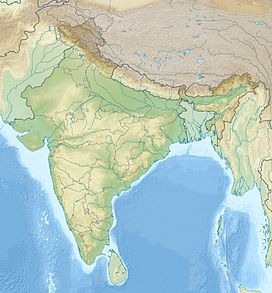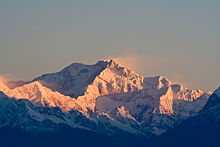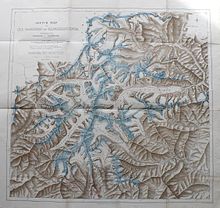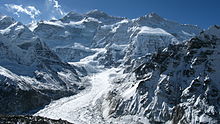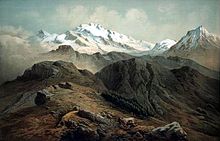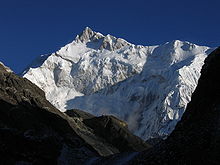- Kangchenjunga
-
Kangchenjunga
Kangchenjunga early in the morning, from Tiger Hill, DarjeelingElevation 8,586 m (28,169 ft) [1]
Ranked 3rdProminence 3,922 m (12,867 ft)
Ranked 29thListing Location  India /
India /  Nepal border
Nepal borderRange Himalayas Coordinates 27°42′09″N 88°08′54″E / 27.7025°N 88.14833°ECoordinates: 27°42′09″N 88°08′54″E / 27.7025°N 88.14833°E Climbing First ascent May 25, 1955
 Joe Brown
Joe Brown
 George Band
George BandEasiest route glacier/snow/ice climb Kangchenjunga is the third highest mountain of the world with an elevation of 8,586 m (28,169 ft) and located along the India-Nepal border in the Himalayas. Kangchenjunga is also the name of the section of the Himalayas and means "The Five Treasures of Snows", as it contains five peaks, four of them over 8,450 m (27,720 ft). The treasures represent the five repositories of God, which are gold, silver, gems, grain, and holy books.[2]
Three of the five peaks – main, central, and south – are on the border of North Sikkim in India and Taplejung District of Nepal, while the other two are completely in Taplejung District. The Kangchenjunga Himal includes twelve more peaks over 7,000 m (23,000 ft).
Until 1852, Kangchenjunga was assumed to be the highest mountain in the world, but calculations made by the Great Trigonometric Survey of India in 1849 came to the conclusion that Mount Everest (known as Peak XV at the time) was the highest and Kangchenjunga the third-highest.[3] Kangchenjunga was first climbed on May 25, 1955 by Joe Brown and George Band, who were part of a British expedition. The British expedition honoured the beliefs of the Sikkimese, who hold the summit sacred, by stopping a few feet short of the actual summit. Most successful summit parties since then have followed this tradition.[4]
Contents
Names
Kangchenjunga is the official spelling adopted by Douglas Freshfield, A.M. Kellas, and the Royal Geographical Society that gives the best indication of the Tibetan pronunciation.[5]
The name Kangchenjunga stems from Bhutia and Tibetan languages. Its name in Nepali is कञ्चनजङ्घा Kanchanjaŋghā. Its name in the local Limbu language is Sewalungma, meaning Mountain that we offer greetings to. Sewalungma is considered sacred in the Kirant religion.
There are a number of alternative spellings which include Kangchen Dzö-nga, Khangchendzonga, Kanchenjanga, Kachendzonga, Kanchenjunga or Kangchanfanga. The final word on the use of the name Kangchenjunga came from His Highness Sir Tashi Namgyal, the Maharaja or chogyal of Sikkim, who stated that "although junga had no meaning in Tibetan, it really ought to have been Zod-nga (treasure, five) Kang-chen (snow, big) to convey the meaning correctly". Following consultations with a Lieutenant-Colonel J.L.R. Weir (British political agent to Sikkim), he agreed that it was best to leave it as Kangchenjunga, and thus the name remained so by acceptance and usage.
Protected areas
The Kangchenjunga transboundary landscape is shared by Bhutan, China, India and Nepal, and comprises 14 protected areas with a total of 6,032 km2 (2,329 sq mi): Kanchenjunga Conservation Area located in Nepal, Kanchenjunga Biosphere Reserve, Barsey Rhododendron Sanctuary, Fambong Lho Wildlife Sanctuary, Kyongnosla Alpine Sanctuary, Mainam Wildlife Sanctuary, Singhba Rhododendron Sanctuary, Pangolakha Wildlife Sanctuary located in Sikkim, Jorepokhari Salamander Sanctuary, Singhalila National Park, Senchel Wildlife Sanctuary, Mahananda Wildlife Sanctuary, Neora Valley National Park located in Darjeeling, and Toorsa Strict Nature Reserve located in Bhutan. These protected areas are habitats for many globally significant plant species such as rhododendrons and orchids and many endangered flagship species such as snow leopard, Asiatic black bear, red panda, Himalayan musk deer, blood pheasant and chestnut-breasted partridge.[6]
Geography
The five peaks of Kangchenjunga are as follows:
Name of peak Height (m) Height (ft) Kangchenjunga Main 8,586 28,169 Kangchenjunga West (Yalung Kang) 8,505 27,904 Kangchenjunga Central (Middle) 8,482 27,828 Kangchenjunga South 8,494 27,867 Kangbachen 7,903 25,925 The huge massif of Kangchenjunga is buttressed by great ridges running roughly due east to west and north to south, forming a giant 'X'. These ridges contain a host of peaks between 6,000 and 8,000 metres. On the east ridge in Sikkim, is Siniolchu (6,888 m/22,600 ft). The west ridge culminates in the magnificent Jannu (7,710 m/25,294 ft) with its imposing north face. To the south, clearly visible from Darjeeling, are Kabru North (7,338 m/24,075 ft), Kabru South (7,316 m/24,002 ft) and Rathong peaks (6,678 m/21,910 ft). The north ridge, after passing through the minor subpeak Kangchenjunga North (7741 m/25,397 ft), contains The Twins and Tent Peak, and runs up to the Tibetan border by the Jongsong La, a 6,120 m (20,080 ft) pass.
Some of the most famous views of Kangchenjunga are from the hill station of Darjeeling. On a clear day, it presents an image not as much of a mountain but of a white wall hanging from the sky. The people of Sikkim revere Kangchenjunga as a sacred mountain. Permission to climb the mountain from the Indian side is rare, but sometimes allowed.[citation needed]
Because of its remote location in Nepal and difficult access from India, the Kangchenjunga region is not much explored by trekkers. It has, therefore, retained much of its pristine beauty. In Sikkim too, trekking into the Kangchenjunga region has just been permitted. The Goecha La trek is gaining popularity amongst tourists. It goes to the Goecha La Pass, located right in front of the huge southeast face of Kangchenjunga. Another trek to Green Lake Basin has recently been opened for trekking. This goes to the Northeast side of Kangchenjunga along the famous Zemu Glacier.
Climbing history
Early reconnaissance and attempts
- In 1848/49, Joseph Dalton Hooker explored parts of the eastern Nepal previously completely unknown to Europeans. He made repeated tours of the river valleys into the foothills leading up to Kangchenjunga, reaching within 22 km (14 mi) of the peak and passes into Tibet.
- In 1855, Hermann Schlagintweit from Germany was put in charge of the Magnetic Survey of India, exploring the vicinity and painting a panorama of Everest and Kangchenjunga, prior to being turned back by Nepalese soldiers.[7]
- In 1883, a party of William Woodman Graham, the British pioneer of Himalayan mountaineering, claimed to have circumnavigated the mountain in March 1882. After climbing an 18,000 ft (5,500 m) peak, they were forced to return to Darjeeling after only a week. They returned in July 1883 with two Swiss guides for a purported attempt whilst climbing other peaks in the area and hunting snow leopard.[8][9][10]
- In 1899, British mountaineer Douglas Freshfield set out with his party comprising the Italian photographer Vittorio Sella. They were the first mountaineers to examine the lower and upper ramparts, and the great western face of Kangchenjunga, rising from the Kangchenjunga Glacier.[5]
- In 1905, a party headed by Aleister Crowley was the first attempt at climbing the mountain. Aleister Crowley had been part of the team attempting the 1902 ascent of K2. The team reached an estimated altitude of 6,500 m (21,300 ft) on the southwest side of the mountain before turning back. The exact height reached is somewhat unclear; Crowley stated that on August 31, "We were certainly over 21,000 ft (6,400 m) and possibly over 22,000 ft (6,700 m)", when the team was forced to retreat to Camp 5 by the risk of avalanche. On September 1, they evidently went further; some members of the team (Reymond, Pache and Salama) "got over the bad patch" that had forced them to return to Camp 5 the day before, and progressed "out of sight and hearing" before returning to Crowley and the men with packs, who could not cross the dangerous section unassisted with their burdens. It is not clear how far Reymond, Pache and Salama had ascended - but in summarizing, Crowley ventured "We had reached a height of approximately 25,000 ft (7,600 m)." Attempting a "mutinous" late-in-the-day descent from Camp 5 to Camp 4, climber Alexis Pache (who earlier that day had been one of three to ascend possibly higher than any before), and three local porters, were killed in an avalanche. Despite the insistence of one of the men that "The demon of Kangchenjunga was propitiated with the sacrifice", Crowley decided enough was enough and that it was inappropriate to continue.[11]
- In 1929, a German expedition led by Paul Bauer reached 7,400 m (24,280 ft) on the northeast spur before being turned back by a five-day storm.
- In 1930, an international expedition led by George Dyhrenfurth, German Uli Wieland, Austrian Erwin Schneider and Englishman Frank Smythe (who published "The Kangchenjunga Adventure" in the same year). The attempt failed due to poor weather and snow conditions.[12]
- In 1931, a second German expedition, led again by Paul Bauer, attempted the northeast spur before being turned back by bad weather, illnesses, and deaths. The expedition retreated after climbing only a little higher than the 1929 attempt.
- In 1954, a reconnaissance of Kangchenjunga's southwest side was made by John Kempe (leader), J.W. Tucker, Ron Jackson, Trevor H. Braham, G.C. Lewis, and Dr. D.S. Mathews.[13] This reconnaissance led to the route used by the successful 1955 expedition.
First ascent
In 1955, Joe Brown and George Band made the first ascent on May 25, followed by Norman Hardie and Tony Streather on May 26. The full team also included John Clegg (team doctor), Charles Evans (team leader), John Angelo Jackson, Neil Mather, and Tom Mackinnon.
The ascent proved that Aleister Crowley's 1905 route (also investigated by the 1954 reconnaissance) was viable. The route starts on the Yalung Glacier to the southwest of the peak, and climbs the Yalung Face, which is 3,000 metres (10,000 ft) high. The main feature of this face is the "Great Shelf", a large sloping plateau at around 7,500 metres (24,600 ft), covered by a hanging glacier. The route is almost entirely on snow, glacier, and one icefall; the summit ridge itself can involve a small amount of travel on rock. The first ascent expedition made six camps above their base camp, two below the Shelf, two on it, and two above it. They started on April 18, and everyone was back to base camp by May 28.[14]
Other notable ascents
- 1973 Climbers Yutaka Ageta and Takeo Matsuda of the Japanese expedition summitted Kangchenjunga West (Yalung Kang) by climbing the SW Ridge.
- 1977 The second ascent of Kangchenjunga, by an Indian Army team led by Colonel Narinder Kumar. They completed the northeast spur, the difficult ridge that defeated the German expeditions in 1929 and 1931.
- 1978 Polish teams made the first successful ascents of the summits Kangchenjunga South (Wojciech Wróż and Eugeniusz Chrobak, 19 May) and Kangchenjunga Central (Wojciech Brański, Zygmunt Andrzej Heinrich, Kazimierz Olech, 22 May).[15]
- 1979 The third ascent, on May 15, and the first without oxygen, by Doug Scott, Peter Boardman and Joe Tasker establishing a new route on the North Ridge[16]
- 1983 Pierre Beghin made the first solo ascent and the first ascent without oxygen.
- 1986 On January 11, Krzysztof Wielicki and Jerzy Kukuczka, Polish climbers, made the first winter ascent.
- 1991 Marija Frantar and Joze Rozman attempted the first ascent by a woman but their bodies were later found below the summit headwall.
- 1991 Andrej Stremfelj and Marko Prezelj completed an alpine-style climb up the south ridge of Kangchenjunga to the south summit (8,494 m).
- 1992 Carlos Carsolio made the only summit that year. It was in a solo climb without supplementary oxygen.[17]
- 1992 Wanda Rutkiewicz, the first woman to ascend and descend K2 and a respected Polish climber, died after she declined to descend in the face of an incoming storm.
- 1995 Benoît Chamoux, Pierre Royer and their Sherpa guide disappeared on October 6 near the summit.
- 1998 Ginette Harrison became the first woman to reach the summit. Until then Kangchenjunga was the only eight-thousander that had not seen a female ascent.
- 2005 Alan Hinkes, a British climber, was the only person to summit in the 50th anniversary of first ascent year.
- 2006 Gerlinde Kaltenbrunner, an Austrian mountaineer, was the second woman to reach the summit.
- 2009 Jon Gangdal and Mattias Karlsson reached the summit, becoming, respectively, the first Norwegian and Swedish mountaineer to summit this mountain.
- 2009 Edurne Pasaban, a Spanish mountaineer, reached the summit, becoming the first woman to summit 12 eight-thousands.[18]
- 2009 Kinga Baranowska became the first Polish woman climber to reach the Summit of Kangchenjunga.[19]
- 2011 Tunc Findik became the first Turkish man to reach the peak of Kangchenjunga, his 7th 14er, with Swiss partner Guntis Brandts via the British 1955 SW Face route.[20][21]
- 2011 Indian Mountaineers [ Basanta Singha Roy and Debasish Biswas ] of Mountaineers' Association of Krishnanagar,{MAK}, West Bengal, India, successfully scaled Kangchenjunga [Main] on 20.05.2011.
In myth
The area around Kangchenjunga is said to be home to the "Kangchenjunga Demon", a type of yeti or rakshasa. A British geological expedition in 1925 spotted a bipedal creature which they asked the locals about, who referred to it as the "Kangchenjunga Demon".[22]
In literature
- In the Swallows and Amazons series of books by Arthur Ransome, a high mountain (unnamed in the book, but clearly based on the Old Man of Coniston in the English Lake District) is given the name "Kanchenjunga" by the children when they climb it in 1931.
- In The Epic of Mount Everest, first published in 1926, Sir Francis Younghusband: " For natural beauty Darjiling (Darjeeling) is surely unsurpassed in the world. From all countries travellers come there to see the famous view of Kangchenjunga, 28,150 feet (8,580 m) in height, and only 40 miles (64 km) distant. Darjiling (Darjeeling) itself is 7,000 feet (2,100 m) above sea-level and is set in a forest of oaks, magnolia, rhododendrons, laurels and sycamores. And through these forests the observer looks down the steep mountain-sides to the Rangeet River only 1,000 feet (300 m) above sea-level, and then up and up through tier after tier of forest-clad ranges, each bathed in a haze of deeper and deeper purple, till the line of snow is reached; and then still up to the summit of Kangchenjunga, now so pure and ethereal we can scarcely believe it is part of the solid earth on which we stand; and so high it seems part of the very sky itself."
- In 1999, official James Bond author Raymond Benson published High Time to Kill. In this story, a microdot containing a secret formula for aviation technology is stolen by a society called the Union. During their escape, their plane crashes on the slopes of Kangchenjunga and James Bond becomes part of a climbing expedition in order to retrieve the formula.
- The Inheritance of Loss by Kiran Desai, which won the 2006 Man Booker Prize, is set partly in Kalimpong, a hill station situated near Kangchenjunga.
Background reading
Some titles are no longer in print but are easily locatable on the Internet.
- Joseph Dalton Hooker Himalayan Journals, 1855. Assistant-director of the Royal Botanic Gardens, Kew.
- Maj Laurence Waddell, Among The Himalayas, 1899; Travels in Sikkim. Book includes the exploration of the south of Kangchenjunga.
- Aleister Crowley The Confessions of Aleister Crowley, Chapters 51, 52 & 53, Tells of the 1905 Kangchenjunga Expedition by he and Dr. Jacot-Guillarmod.
- Douglas Freshfield Round Kangchenjunga - A Narrative of Mountain Travel and Exploration, published by Edward Arnold 1903 (Publisher to the H.M. India Office).
- Paul Bauer Himalayan Campaign (Blackwell, 1937) is the story of Bauer’s two attempts in 1929 and 1931, republished as Kangchenjunga Challenge (William Kimber, 1955).
- Paul Bauer The German Attack on Kangchenjunga, The Himalayan Journal, 1930 Vol. II.
- Lieut. Col. H.W. Tobin Exploration and Climbing in The Sikkim Himalaya The Himalayan Journal, April 1930 Vol. II. Provides the early exploration and climbing attempts on Kangchenjunga.
- F.S. Smythe The Kangchenjunga Adventure, 1930 to 1931. Victor Gollancz, Ltd. Smythe was the team member responsible for writing and sending the dispatches to The Statesman in Calcutta, (Mr. Alfred Watson Editor), who transmitted the dispatches to The Times (editors Deakin & Bogaerde), during the expedition of 1930 * example.
- Prof. G.O. Dyhrenfurth The International Himlayan Expedition, 1930, The Himalayan Journal, April 1931, Vol. III. Details their attempt on Kangchenjunga.
- H.W. Tilman The ascent of Nanda Devi, June 7, 1937,Cambridge University Press. Relates the story of their intention to climb Kangchenjunga.
- Irving, R. L. G., Ten Great Mountains (London, J. M. Dent & Sons, 1940)
- John Angelo Jackson More than Mountains 1955. Book containing data on the 1954 Kangchenjunga reconnaissance. Jackson was also a team member of the 1st ascent of Kangchenjunga in 1955, also relates the Daily Mail "Abominable Snowman" or Yeti Expedition, when the first trek from Everest to Kangchenjunga was accomplished * [1]. Relevant pages 97 onwards with two detailed maps.
- Charles Evans Kangchenjunga The Untrodden Peak, Hodder & Stoughton, Leader of the 1955 expedition. Principal of the University College of North Wales, Bangor. Foreword by His Royal Highness the Duke of Edinburgh, K.G.
- Joe Brown, The Hard Years, tells his version of the first ascent of Kangchenjunga in 1955.
- Colonel Narinder Kumar, Kangchenjunga: First ascent from the north-east spur, 1978, Vision books. Includes the second ever ascent of Kangchenjunga and the first from the North-East Spur on the Indian side of the mountain. See also Himalayan Journal Vol. 36 and 50th Anniversary Edition
- Peter Boardman, Doug Scott, Sacred Summits – A Climber's Year, 1982; Includes the 1979 ascent of Kangchenjunga with Joe Tasker and Doug Scott. Also in The Himalayan Journal Vol 36.
- John Angelo Jackson Adventure Travels in the Himalaya Indus Publishing 2005, Recounts in more detail the first ascent of Kangchenjunga.
- Simon Pierse, Kangchenjunga: Imaging a Himalayan Mountain, University of Wales, School of Art Press, 2005. ISBN 978-1899095223. An anthology of word and image published to coincide with the 50th anniversary of the first ascents of Kangchenjunga. Well illustrated with reproductions of paintings, prints and photographs describing the climbing history and cultural significance of the mountain. Preface by George Band.
The above Himalayan Journal References were all also reproduced in the "50th Anniversary of the First Ascent of Kangchenjunga" The himalayan Club, Kollkata Section 2005.
- Khangchendzonga: Sacred Summit, a book by Pema Wangchuk and Mita Zulca published from Sikkim. The book details the stories and legends celebrated by the communities living in the Kangchenjunga's shadow, goes over the exploits of the early explorers and mountaineers. Chapters cover what Khangchendzonga means to Buddhism, mapping, early explorers, Alexander Kellas, early expeditions, the first ascent in 1955, the Indian Army ascent (1977), the first British ascent (1979), women climbers, the Tiger climbers, the yeti, and more. Profusely illustrated with many period photos.
Articles, reviews and media
- The Geographer at High Altitudes, "Climbing on the Himalaya and other Mountain Ranges", By J. Norman Collie, F.R.S. Edinburgh: David Douglas. 1902.
- The Glaciers of Kangchenjunga Douglas Freshfield The Geographical Journal, Vol. 19, No. 4 Apr., 1902, pp. 453–472
- Round Kangchenjunga. A Narrative of Mountain Travel and Exploration, Douglas W. Freshfield Bulletin of the American Geographical Society, Vol. 36, No. 2 1904
- The Mount Everest Expedition, C. K. Howard-Bury. The Geographical Journal, Vol. 59, No. 2 Feb., 1922, pp. 81–99. see also Yeti. pp. 97 onwards with good detailed maps.
- "General Bruce's Illness a Serious handicap" "The Times", (British) World Copyright, Lt. R.F.Norton, April 19, 1924. Expedition in the Kangchenjunga area.
- Account of a Photographic Expedition to the Southern Glaciers of Kangchenjunga in the Sikkim Himalaya, N. A. Tombazi, The Geographical Journal, Vol. 67, No. 1 Jan., 1926, pp. 74–76
- An Adventure to Kangchenjunga, Hugh Boustead, The Geographical Journal, Vol. 69, No. 4 (Apr., 1927), pp. 344–350
- The Times Literary Supplement, Thursday, December 11, 1930. "The Kangchenjunga Adventure", F.S. Smythe.
- Im Kampf um den Himalaja, Paul Bauer. The Kangchenjunga Adventure, F. S. Smythe, Himalaya: Unsere Expedition, G. O. Dyhrenfurth. 1930
- The Times Literary Supplement, Thursday, April 9, 1931. "Kangchenjunga", Paul Bauer.
- The Imperial Gazetteer of India. Vol. XXVI, The Geographical Journal, Vol. 79, No. 1 Jan., 1932, pp. 53–56
- Recent Heroes of Modern Adventure, T. C. Bridges; H. Hessell Tiltman, The Geographical Journal, Vol. 81, No. 6 Jun., 1933, p. 568
- Um Den Kantsch: der zweite deutsche Angriff auf den Kangchendzönga, Paul Bauer, 1931. The Geographical Journal, Vol. 81, No. 4 Apr., 1933, pp. 362–363
- Himalayan Campaign: The German Attack on Kangchenjunga, Paul Bauer; Sumner Austin The Geographical Journal, Vol. 91, No. 5 May 1938, p. 478
- The Times Literary Supplement, Friday, December 21, 1956. "Kangchenjunga: The Untrodden Peak", Charles Evans.
- Kangchenjunga Climbed, Charles Evans; George Band, The Geographical Journal, Vol. 122, No. 1 Mar., 1956, pp. 1–12.
References
- ^ Figures regarding the exact height of Kangchenjunga differ. Heights of 8,598 metres (28,209 ft) and 8,586 m (28,169 ft) are often given. On official 1:50,000 Nepalese mapping, the lower height is given, so this is given on this page also.
- ^ Carter, H. Adams (1985). "Classification of the Himalaya". American Alpine Journal (American Alpine Club) 27 (59): 109–141. http://c498469.r69.cf2.rackcdn.com/1985/109_carter_himalaya_aaj1985.pdf. Retrieved May 1, 2011.
- ^ Gillman, Peter, ed (1993). Everest — The Best Writing and Pictures from Seventy Years of Human Endeavour. Little, Brown and Company. pp. 11–12. ISBN 0-316-90489-3.
- ^ Everest News.com. "Kangchenjunga History". http://www.k2news.com/kanghistory.htm. Retrieved 2008-04-12.
- ^ a b Freshfield, D. W. (1903) Round Kangchenjunga: a narrative of mountain travel and exploration. Edward Arnold, London.
- ^ Chettri, N., Bajracharya, B., Thapa, R. (2006) Feasibility Assessment for Developing Conservation Corridors in the Kangchenjunga Landscape. In: Chettri, N., Shakya, B., Sharma, E. (eds.) (2008) Biodiversity Conservation in the Kangchenjunga Landscape. International Centre for Integrated Mountain Development, Kathmandu. Pages 21–30.
- ^ Kapadia, H., Kapadia, G. (2005). Into the Untravelled Himalaya. New Delhi: Indus Publishing. ISBN 8-1738-7181-7.
- ^ (Latest Intelligence (From Our Correspondents): India). The Times (London). Mon, September 3, 1883. Issue 30915, col A, p. 3.
- ^ The Times (London). Thu, September 13, 1883. Issue 30924, col A, p. 6.
- ^ (Latest Intelligence (From Our Correspondents): India). The Times (London). Mon, October 22, 1883. Issue 30957, col A, p. 5.
- ^ Crowley, A.; Symonds, J.; Grant, K. (1989) The confessions of Aleister Crowley : an autobiography Chapter 52 Arkana, London
- ^ "To Conqueror Kanchanjanga" Popular Mechanics, January 1930, maps of route in attempt and equipment
- ^ The Himalayan Journal Vol. XIX.
- ^ Evans, C., Band, G. (1956) "Kangchenjunga Climbed". The Geographical Journal, March 1956, 122 (1): 1–12
- ^ Wojciech Wróż: Święta góra Sikkimu. Warszawa: "Sport i Turystyka", 1982. ISBN 83-217-2377-2. (Polish)
- ^ Scott, Douglas (1980). "Kangchenjunga from the North". American Alpine Journal 1980 (New York, NY, USA: American Alpine Club) 22 (53): 437–444. ISBN 978-0-930410-76-6.
- ^ "by Explorersweb". AdventureStats. http://www.adventurestats.com/tables/kangchenjunga.shtml. Retrieved 2011-06-14.
- ^ "List of Kangchenjunga ascents". 8000ers.com. 2008-02-13. http://www.8000ers.com/cms/content/view/54/193/#tables. Retrieved 2011-06-14.
- ^ Kinga Baranowska
- ^ "Tunç Fındık zirvede". Cnnturk.com. 2011-05-20. http://www.cnnturk.com/2011/yasam/diger/05/20/tunc.findik.zirvede/617339.0/. Retrieved 2011-06-14.
- ^ "Turkish climber Tunç Fındık goes to Kang, his 7th 8000 m summit, spring 2011 / Members news / "14 Eight Thousanders"". 14-8000m.com. http://14-8000m.com/membersnews/all/item_2283/. Retrieved 2011-06-14.
- ^ The Abominable Snowman: Bear, Cat or Creature?[dead link]
External links
- Aleister Crowley's detailed account of the 1905 attempt on Kangchenjunga
- Kangchenjunga History for a more detailed up to date account of the mountain's history and ascents.
- Kangchenjunga on Peakware - photos
- 50th Kangchenjunga Reunion 2005 - The Hindu
- The Alpine Club Kangchenjunga Exhibition
- Kanchendzönga (German)
- Glacier Research Image Project presents photos tracking 24 years of changes in glaciers at Kangchenjunga.
Eight-thousanders Everest · K2 · Kangchenjunga · Lhotse · Makalu · Cho Oyu · Dhaulagiri · Manaslu · Nanga Parbat · Annapurna · Gasherbrum I · Broad Peak · Gasherbrum II · XixabangmaCategories:- Mountains of Nepal
- Mountain ranges of Nepal
- Mountains of Sikkim
- Eight-thousanders
- Sacred mountains
- India–Nepal border
- Himalayas
- International mountains of Asia
Wikimedia Foundation. 2010.


